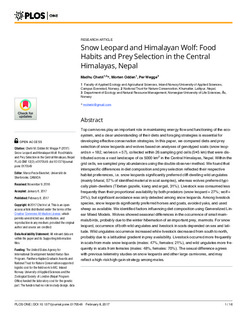Snow Leopard and Himalayan Wolf: Food Habits and Prey Selection in the Central Himalayas, Nepal
Journal article, Peer reviewed
Published version
Permanent lenke
http://hdl.handle.net/11250/2450027Utgivelsesdato
2017Metadata
Vis full innførselSamlinger
Sammendrag
Top carnivores play an important role in maintaining energy flow and functioning of the ecosystem, and a clear understanding of their diets and foraging strategies is essential for developing effective conservation strategies. In this paper, we compared diets and prey selection of snow leopards and wolves based on analyses of genotyped scats (snow leopards n = 182, wolves n = 57), collected within 26 sampling grid cells (5×5 km) that were distributed across a vast landscape of ca 5000 km2 in the Central Himalayas, Nepal. Within the grid cells, we sampled prey abundances using the double observer method. We found that interspecific differences in diet composition and prey selection reflected their respective habitat preferences, i.e. snow leopards significantly preferred cliff-dwelling wild ungulates (mainly bharal, 57% of identified material in scat samples), whereas wolves preferred typically plain-dwellers (Tibetan gazelle, kiang and argali, 31%). Livestock was consumed less frequently than their proportional availability by both predators (snow leopard = 27%; wolf = 24%), but significant avoidance was only detected among snow leopards. Among livestock species, snow leopards significantly preferred horses and goats, avoided yaks, and used sheep as available. We identified factors influencing diet composition using Generalized Linear Mixed Models. Wolves showed seasonal differences in the occurrence of small mammals/birds, probably due to the winter hibernation of an important prey, marmots. For snow leopard, occurrence of both wild ungulates and livestock in scats depended on sex and latitude. Wild ungulates occurrence increased while livestock decreased from south to north, probably due to a latitudinal gradient in prey availability. Livestock occurred more frequently in scats from male snow leopards (males: 47%, females: 21%), and wild ungulates more frequently in scats from females (males: 48%, females: 70%). The sexual difference agrees with previous telemetry studies on snow leopards and other large carnivores, and may reflect a high-risk high-gain strategy among males.
